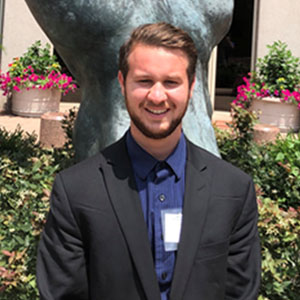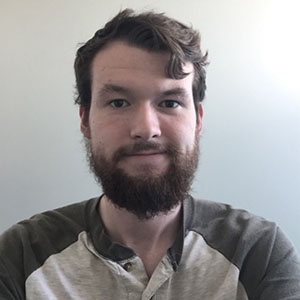National Intern Day 2020
July 30, 2020
Here at the NOAA Office of Ocean Exploration and Research (OER), one of the most rewarding aspects of our mission is encouraging and supporting the next generation of ocean explorers. Every year, we welcome a new cohort of interns who contribute an incredible range of ideas, fresh perspectives, and hard work to our operations. From engineering to science communication, marine biology to mapping, their range of interests have run the gamut over the years, embodying the interdisciplinary nature of ocean exploration. Learn more about this year’s interns and the programs that supported them below.

Adriana Muñoz-Soto
Adriana is a mechanical engineering major and rising senior at the University of Puerto Rico, Mayagüez Campus. This summer, as an undergraduate scholar through the NOAA Educational Partnership Program with Minority Serving Institutions (EPP/MSI), she has been working with Dr. Brennan Phillips of the University of Rhode Island and OER’s Catalina Martinez. Her project involves the design of a 3D-printed enclosure to fit a Raspberry Pi-based deep-sea camera and lighting system. Over the past nine weeks, she has been designing, redesigning, and 3D printing various iterations of an internal chassis, outside housing, and fins. The work recently entered the testing phase, which has been remarkably collaborative given that she is based in Puerto Rico and Dr. Phillips is in Rhode Island. Adriana explains, “Dr. Phillips goes out to the ocean [to test the designs] and comes back with what worked, as well as suggestions to improve for our next deployment.” These conversations take place virtually, but lead to real-world improvements in design as Adriana sends technical designs to Dr. Phillips’ 3D printer over a thousand miles away. Adriana finds the tangible results rewarding, “Working with 3D printing, we can physically see the end result of what we’ve been working on for weeks, and the details we worked so hard on, finally come to life.” She’s also found that mentorship has played a key role in defining her experience this summer, “I was able to receive amazing mentorship from professionals that cared about me as a engineering student, giving me detailed advice and feedback, but also as a minority and as an individual.”

Jason Gronich
Jason is a senior undergraduate working toward a bachelor’s degree in marine science and a minor in statistics from California State University, Monterey Bay. During his summer internship as a Hollings Scholar with OER’s Science and Technology Division and the National Marine Fisheries Service, he created a full taxonomic inventory of mesopelagic organisms recorded on NOAA Ship Okeanos Explorer expeditions conducted at Johnston Atoll and the Musicians Seamounts in 2017. He assigned all the organisms into four major functional groups and ran statistical models to determine how these creatures are affected by environmental factors such as oxygen concentration, practical salinity, temperature, and the depth of the deep-scattering layer. He elaborates, “On a daily basis I analyze video footage and acoustic data, and conduct statistical tests… The end result includes a presentation and report and possibly, in a year, a publication.”
Jason has been entranced by this project since the start, and the opportunity to contribute new data about the little-known midwater communities of Johnston Atoll and the Musicians Seamounts.

Phoebe Lease
Phoebe is a rising senior at Smith College where she is an American studies major with a concentration in economics and climate change. As a NOAA College-Supported Intern (through Smith College’s Agnes Shedd Andreae Fellowship for NOAA internships), she is working with the OER Science and Technology and Engagement Divisions. Her project involves writing public-facing articles on complex ocean exploration technologies, ranging from environmental DNA to synthetic aperture sonar. For Phoebe, the internship was an opportunity to practice taking in complex information about emerging technologies and translating it for a general audience. She elaborates, “It's been really interesting to see NOAA and OER’s approach to engaging the public and increasing scientific literacy. Getting people excited about science is a delicate balance. It's not enough to publish a report or article and call it ‘accessible,’ you have to make it both comprehensible and relevant to the reader.”
Phoebe sees ample opportunity for her internship experience to help inform her future trajectory:
“This was a great opportunity for me as a humanities student to be immersed in a science environment. I think an interdisciplinary approach to any subject is important... I would recommend that future communications students apply to this internship and other science communication programs, regardless of their intended writing genre, because science impacts all issues.
I am hoping to go into the climate change communications field, so this experience has been very valuable to me. I know that technology will play an important role in climate change mitigation, and so being able to convey complex technology to an audience is a good skill to have for my future work.”

Ryan Ware
Ryan is a rising senior at Coastal Carolina University, where he studies marine science and biology. This summer, he is a Hollings Scholar working with the OER Exploration and Expeditions Division. His project centers around developing a new method for comparing deep-sea ecosystems using data collected by remotely operated vehicles (ROV).
The usual process of evaluating ROV data starts with watching each ROV dive video and recording detailed observations about the habitat and organisms that appear. This process can be very time intensive, often requiring 4-6 hours to review and annotate a single hour of video data. Ryan’s research project is aimed at developing a methodology to rapidly assess ecosystems and reduce the time spent making annotations or watching recordings. His technique involved subsampling, or recording observations at periodic intervals rather than continuously and working at a higher taxonomic level to speed up observations, and then comparing results to see if the rapid approach held up in terms of data quality.
Ryan approached his internship keeping the scientific method well in mind, and advises future interns to do the same: “Sometimes, you may have an idea and be so sure it will work, only to put it into practice and the results tell you it doesn't. However, this is still useful information. As long as you've developed something, tested it, and followed through, someone else will be able to read it and get something out of it, and that's to say nothing of what you yourself learned. Learning and growth is the whole point, after all.”
For more information about other NOAA internships, including OER’s Explorer-in-Training program, check out NOAA's Student Opportunities page.